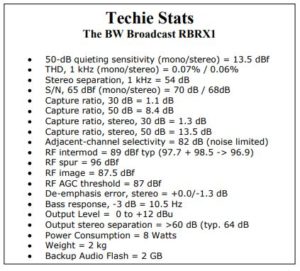The BW Broadcast – RBRX1 FM Tuner

[March 2011] Getting clean, clear audio from a marginal signal can be tricky. Robert Reymont reports on how a tuner introduced last year solved a difficult reception problem.
Recently I had the opportunity to install a BW Broadcast RBRX1 FM tuner. It has turned out to be the solution I have been seeking for a long time.
![]()
A Difficult Pickup
For years I had problems getting a clean usable signal to feed a translator on South Mountain in Phoenix, AZ, the home for a full slate of full power FM and TV stations. With all that RF, trying to pick up a Class C-1 station more than 60 miles away in order to provide a signal for a 10 Watt translator was extremely difficult.
To give you an idea of the challenge that I was facing, 700 kHz below the desired carrier was a 100 kW station operating in full HD mode with 14% injection. And operating 400 kHz above the desired carrier was another 100 kW station, planning full HD operation in the near future. Both of these stations transmitters were within a half mile of my receive antenna.
Even though the tuner we were using was equipped with a band-pass filter and notch filters for the adjacent stations, their signals still desensed the tuner, making reception of the desired signal difficult.
In fact, due to reduced power of the main inbound signal, at times the reception fell below the noise floor causing the receiver to mute.
Problem Solved
The RBRX1 uses several techniques to improve reception. It employs an image cancelling, high dynamic range front-end mixing system for an on-channel IF conversion. Working together with a digital signal processed steep IF band filtering, the RBRX1 achieves the excellent adjacent channel filtering that makes this tuner an ideal reception tuner for distant FM signals.
The BW Broadcast tuner proved its mettle immediately upon installation – the required distant station was pulled in cleanly, and passed on solidly to the translator via the composite output.
I set the pre-emphasis to 75 µs on the audio menu (the RBRX1 can provide the complete composite signal, so I turned off the pre-emphasis in the transmitter to avoid a double pre-emphasis), then selected the multiplex generator output (MPX) and navigated to the MPX setting for “Radio,” adjusting the level to match the transmitter and maintain 100% modulation.
This tuner also features more than 50 possible adjustments for High Cut, Soft Mute, RDS, Outputs, and a Scheduler for day-part processing.
Easy Menu Navigation
Navigating the menu was easy, using the touch sensitive “wheel” with the enter and exit keys. Text input is available for setting call letters. Saving the setting is also easy.
![]()
The backplane of the RBRX1 has provisions analog, digital, and two multiplex outputs. There are analog, digital, and USB inputs for audio playback in the case the main feed should fail. RJ45 Ethernet and RS-232/GPIO connections are provided for remote control and configuration via a web browser interface that will work even on smartphones.

In the case where the tuner is to be used for critical monitoring in the studio, there is a sister model, the RX1, without the multiplex outputs.
In conclusion, this receiver filled the bill for a top of the line monitor relay receiver for a translator in a congested signal area.

– – –
Robert Reymont is president of Double R Consulting in Mesa, AZ. His email is robert@reymont.com
